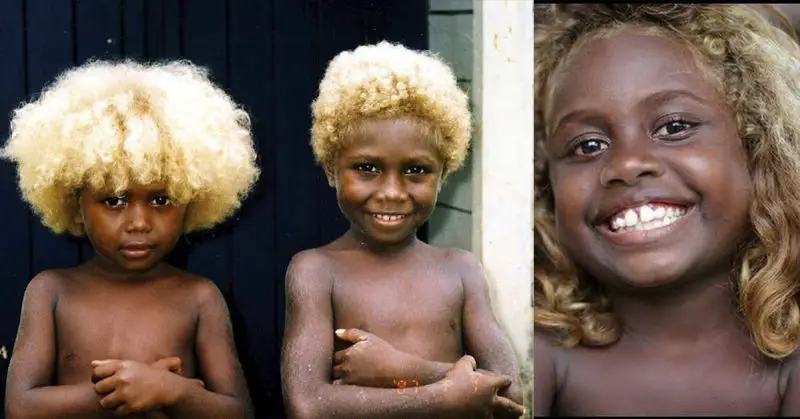Naturally-occurring blond hair is primarily found in global populations with Northern-Europeans descent, but the Melanesians of the Solomon Islands have become popular over the decades for their striking physical features: lovely dark skin and bright blond hair. [1]

The Melanesians migrated about 100,000 years ago to a sub-region of Oceania extending from New Guinea Island in the south of the Pacific Ocean to the Arafura Sea. Papua New Guinea, Fiji, Vanuatu, Solomon Island, and New Caledonia are some of the countries that make up this region, being most of the islands northeast of Australia.
About 5 to 10 percent of the indigenous Melanesians of the Solomon Islands have dark skin and blond hair. The blond hair color is more common in children because, in every race, hair tends to darken as a person gets older. However, the striking feature has attracted several hundreds of researchers to the islands, aiming to determine the cause of the unusual hair color.

Several theories… Until the truth was discovered
Scientists over the years have attributed the blond color to a possibility of the Melanesians cross-breeding with the Europeans who were associated with the islands in past centuries. Others claimed it was caused by the bleaching sun or high levels of salt in the water. Another theory attributed it to high fish intake since fish is usually a staple food for islanders.
A predominantly Christian people, the Melanesians speak over 1000 languages including Creole and several variations of Pidgin. Language variations have been used as a basis for research among the people.
A groundbreaking discovery was made by a Canadian geneticist Sean Myles, an assistant professor at the Nova Scotia Agricultural College in Canada. [2] He first visited Melanesia in 2004 to investigate the correlations between hair gene and language variations in the region.
“They have these very dark skin and bright blond hair. It was mind-blowing,” he said. “As a geneticist on the beach watching the kids playing, you count up the frequency of kids with blond hair, and say, ‘Wow, it’s 5 to 10 percent.’ That’s not very far off from the proportion of blond-haired people in Europe.”
In 2009, Myles returned to Melanesia with Professor Nicholas Timpson of the University of Bristol, a genetic epidemiologist. They spent several months collecting hair and saliva samples from 1209 Melanesians. In September 2010, at the Bustamante laboratory in Stanford, Eimear Kenny, a postdoctoral scholar analyzed the samples.
Upon comparing 43 blond islanders and 42 brown-haired islanders, they discovered that 26% of the Melanesians in the Solomon Islands carried two copies of a mutant recessive gene more common in the children. The people have a native TYRP1 gene that is partly responsible for the blond hair and dark skin. It was also found to be different from the gene that causes blue eyes in black people.
They analyzed the genomes of 52 other people from around the world and concluded that the mutation is peculiar to the Melanesians and absent in the Europeans. The blond hair was not caused by cross-breeding with native whites but was developed independently by the Melanesians, a discovery Kenny described as “unexpected and fascinating.”

Skin like dark pearls, hair like white gold…
According to the Bustamante laboratory, research still needs to be conducted to discover more about the genetic information of the Melanesian people. They are seeking funding to continue their studies.
“If we’re going to be designing the next generation of medical treatments using genetic information and we don’t have a really broad spectrum of populations included, you could disproportionately benefit some populations and harm others. For instance, the genetics of skin pigmentation might be different there too — not the same as in Europe or Africa or India. We just don’t know.”
The Melanesians are quiet people who still have little to no communication with the rest of the world.





Reference:
- ” The Origin of Blond Afros in Melanesia ” Science Mag Erin Loury. Retrieved 12-11-19
- ” Naturally blond hair in Solomon Islanders rooted in native gene, Stanford study finds.” Eureka Alert. Stanford University Medical Center. Retrieved 12-11-19


